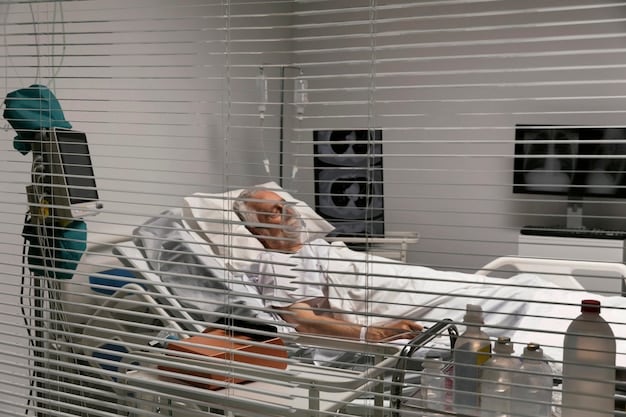Addiction Treatment Levels: A Comprehensive Guide to Recovery

Addiction treatment involves various levels of care, ranging from detox and inpatient programs to outpatient services and aftercare support, tailored to meet individual needs for a successful recovery.
Navigating the world of addiction treatment can be overwhelming. This comprehensive guide breaks down the different levels of addiction treatment, providing clarity and understanding to help you or your loved ones find the most effective path to recovery. What are the Different Levels of Addiction Treatment? A Comprehensive Guide explores the options.
Understanding the Spectrum of Addiction Treatment
Addiction is a complex disease that requires a multifaceted approach to treatment. Understanding the different levels of care available is crucial in selecting the most appropriate and effective treatment plan. These levels range from intensive, medically supervised programs to less intensive outpatient options.
Knowing these levels can empower individuals and families to make informed decisions about their care. Finding the right fit is key to fostering lasting recovery.
Why Different Levels of Treatment Exist
The varying levels of addiction treatment exist to cater to the unique needs of each individual. Factors such as the severity of the addiction, co-occurring mental health disorders, and personal circumstances all play a role.
- Severity of Addiction: Individuals with severe addictions often require intensive, inpatient treatment.
- Co-occurring Disorders: Those with mental health issues alongside addiction may need specialized programs.
- Personal Circumstances: Outpatient programs can be suitable for individuals with milder addictions and strong support systems.
Ultimately, the goal is to provide the right intensity of care at the right time to achieve the best possible outcomes.
Detoxification: The First Step Towards Recovery
Detoxification, often referred to as detox, is typically the first stage of addiction treatment. It involves clearing the body of drugs and alcohol while managing withdrawal symptoms. Medical supervision is often necessary to ensure safety and comfort.
This crucial initial step helps stabilize patients and prepare them for further treatment.

Medical Detox vs. Non-Medical Detox
Medical detox involves the use of medications to alleviate withdrawal symptoms and manage any complications. Non-medical detox relies on natural methods and supportive care without medication.
Medical detox is generally recommended for severe addictions or individuals with underlying health conditions. Non-medical detox may be suitable for milder addictions and those in good physical health.
- Medically Assisted Detox: Medications can reduce withdrawal symptoms and cravings.
- Supportive Care: Provides a safe and comfortable environment.
- Monitoring: Healthcare professionals monitor vital signs and address any complications.
Safe detoxification sets the stage for ongoing therapy and recovery.
Inpatient/Residential Treatment: Intensive Care for Lasting Change
Inpatient or residential treatment involves living at a treatment facility while receiving intensive therapy and support. This level of care offers a structured environment free from triggers and distractions, allowing individuals to focus solely on their recovery.
It is often recommended for individuals with severe addictions, co-occurring disorders, or those who require a high level of structure.
Benefits of Inpatient Treatment
Inpatient treatment offers several advantages. It provides a safe and supportive environment, promotes consistent therapy, and fosters a sense of community among residents.
The structured setting and round-the-clock support can be particularly beneficial for those struggling with intense cravings or relapse risk.
- Structured Environment: Eliminates triggers and distractions.
- Intensive Therapy: Provides individual, group, and family therapy.
- 24/7 Support: Access to medical and therapeutic support at all times.
Inpatient care provides a solid foundation for sustained recovery.
Partial Hospitalization Programs (PHP): A Bridge Between Inpatient and Outpatient Care
Partial Hospitalization Programs (PHP) offer a structured treatment environment similar to inpatient care but allow individuals to return home each evening. This level of care provides intensive therapy and support during the day while enabling patients to maintain some connection to their home life.
PHP is often suitable for individuals who need more intensive care than traditional outpatient programs but do not require 24/7 supervision.
How PHP Differs From Inpatient and Outpatient Treatment
PHP fills the gap between inpatient and outpatient treatment. It provides a higher level of care than standard outpatient programs but allows for greater independence than inpatient settings.
This balance can be particularly beneficial for individuals transitioning from inpatient care or those who need more support than traditional outpatient services offer.

- Intensive Therapy: Daily individual and group therapy sessions.
- Medical Monitoring: Regular check-ups to monitor progress and health.
- Flexibility: Allows individuals to return home each evening.
Partial hospitalization programs offer a crucial step-down option for continued healing.
Intensive Outpatient Programs (IOP): Flexible Support for Ongoing Recovery
Intensive Outpatient Programs (IOP) offer structured therapy and support services on a part-time basis. Individuals attend treatment sessions several times per week while continuing to live at home and maintain their daily routines.
IOP is often suitable for those transitioning from inpatient or PHP or for individuals with moderate addictions who need ongoing support.
Key Components of an IOP
IOP typically includes individual and group therapy, educational sessions, and relapse prevention strategies. The goal is to provide ongoing support while enabling individuals to integrate recovery into their daily lives.
The flexibility of IOP allows individuals to maintain their work, school, and family responsibilities while still receiving necessary treatment.
- Individual Therapy: Addresses personal issues and promotes coping skills.
- Group Therapy: Fosters peer support and learning from others’ experiences.
- Relapse Prevention: Equips individuals with strategies to avoid relapse.
IOP’s adaptable nature supports lasting sobriety.
Outpatient Treatment and Aftercare: Sustaining Long-Term Recovery
Outpatient treatment and aftercare involve ongoing therapy, support groups, and other services designed to sustain long-term recovery. This level of care is often a continuation of previous treatment or a starting point for individuals with milder addictions.
The goal is to provide continued support and strategies for maintaining sobriety and preventing relapse.
The Importance of Aftercare
Aftercare is crucial for preventing relapse and maintaining long-term sobriety. It provides ongoing support and guidance as individuals navigate the challenges of life in recovery.
Regular therapy, support group meetings, and alumni programs can all contribute to a strong foundation for sustained sobriety.
- Continued Therapy: Ongoing support for personal growth and relapse prevention.
- Support Groups: Peer support and shared experiences.
- Alumni Programs: Connecting with others in recovery and giving back to the community.
Comprehensive aftercare dramatically improves recovery outcomes.
| Key Point | Brief Description |
|---|---|
| 💪 Detoxification | The initial process to clear the body of addictive substances. |
| 🏥 Inpatient Treatment | Intensive care within a residential facility. |
| ☀️ Partial Hospitalization (PHP) | Daytime intensive therapy with evenings at home. |
| 🌱 Outpatient Programs | Ongoing flexible support and therapy. |
What are common signs of addiction?
Family history, mental health, past traumas, social circle, type of substance.
How important is a support system during recovery?
Peer support and alumni programs can contribute to a strong foundation for sustained sobriety.
What is the role of medication in addiction treatment?
Medication can reduce withdrawal symptoms and cravings.
How long does addiction treatment typically last?
It provides ongoing support and guidance as individuals navigate the challenges of life in recovery.
What are some strategies for preventing relapse after treatment?
Regular therapy, support group meetings, and alumni programs can all contribute to a strong foundation for sustained sobriety.
Conclusion
Understanding the different levels of addiction treatment is essential for making informed decisions and finding the most effective path to recovery. From detox to outpatient care, each level offers unique benefits and support tailored to individual needs, increasing the chances of a successful and lasting recovery journey.





